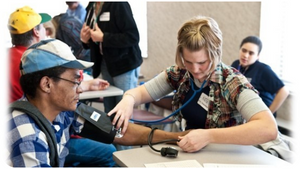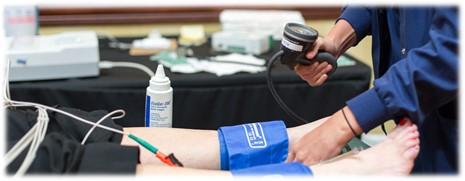PILOT PROJECTS
PILOT PROJECTS
Vascular Care for the Underserved™ is a program offered by the Society for Vascular Surgery (SVS) Foundation to support outreach projects explicitly designed to explore solutions to the significant disparities seen in the delivery of vascular surgical care across the United States. Underserved populations affected most typically include American Indian, African American, and Hispanic communities, where poor social determinants of health often compound disparities. Factors including lower socioeconomic status, poor education, suboptimal housing, limited food resources, limited transportation, and increased violence lead to a lack of access to quality health care. Rural geographic areas are also disproportionately affected due to a lack of providers and resources to identify and treat vascular disease promptly. Some isolated inner-city regions may also be paradoxically at significant risk despite perceived proximity to health care providers and care delivery.

Vascular Care for the Underserved™ and the SVS Foundation look to grow donor-foundation relationships to fund this program. In a phased approach to roll out, Vascular Care for the Underserved™ first supports smaller pilot projects in underserved areas to define existing disparities better and identify obstacles to vascular care delivery. Once successes from these pilots are realized, larger longitudinal program funding is anticipated to facilitate impactful intervention(s) in the areas of greatest need. An eventual final phase would then be focused on coordinating these local initiatives into an integrated regional/national vascular strategy.
Embedded in the outreach process are several essential concepts. First, the Vascular Care for the Underserved™ program looks to identify existing caregivers in underserved areas and work to educate, support, and empower them to be more knowledgeable and aware in identifying vascular problems and patients at risk, implementing prevention strategies, and in early detection and referral for intervention in patients with risk of significant morbidity or mortality. This can be approached in different ways depending on specific needs but, in most cases, will include providing user-friendly educational materials with information regarding vascular disease presentation and management, hands-on instruction concerning critical historical and physical exam cues for vascular disease, provision of resources and education like hand-held Doppler or portable duplex ultrasound capability, and scheduled local vascular screening events. Vascular Care for the Underserved™ teams will provide local providers with real-time consultative support and tertiary referral avenues for a comprehensive evaluation and intervention to reinforce these local efforts.
In summary, the Vascular Care for the Underserved™ program will help highlight underserved areas with the greatest need in vascular care and discover novel solutions to improve prevention, early diagnosis, and treatment in these vulnerable populations. Solutions will combine strengthening local resources for patient care with expert referral networks for patients in need of advanced or immediate treatment. Follow the guidelines below and apply to lead a VISTA pilot project in your area to get involved.
PROPOSAL GOALS AND REQUIREMENTS
Expected Project Goals
Ideal proposals would describe a multidisciplinary approach to address the following goals:
- Clearly define the underserved community your project is targeted to benefit
- Define the degree of disparity in that community with respect to vascular health care access and delivery and disease outcomes
- Directly identify and assist local providers and other service organizations with addressing significant gaps in knowledge, clinical examination methods, point-of-care diagnostics, and other determinants of vascular health and disease
- Directly identify and empower patients and at-risk individuals with improved knowledge about risk for and early signs of vascular disease and the availability of vascular care resources locally in their community
- Based on these experiences, develop and test solutions to address the barriers found to vascular health care delivery that are implementable, scalable, and potentially effective and sustainable
Proposed Strategies
Vascular Care for the Underserved™ leadership recognizes that not one single outreach model will work in every community in every country region. However, what is anticipated is that common threads will emerge from each pilot project with identifiable common target areas of need and initial best practices for an outreach intervention. The following are concepts that should be integrated into an ideal proposal as they pertain to your local challenges with a clear description of their specific relevance:

- Clear description of the level of disparity in your community with a detailed determination of the need
- An analysis of key social determinants affecting healthcare delivery in that community (as defined by the US Department of Health and Human Services Office of Disease Prevention and Health Promotion (ODPHP)):
- Economic Stability
- Education Access and Quality
- Neighborhood and Built Environment
- Social and Community and Context
- Health Access and Quality
-

Strategy to identify specific target communities (i.e., neighborhoods, towns, cities, rural counties) and existing providers in those communities with whom to interact
- Education and Awareness
- Describe a planned approach to education, including utilization of supporting print and/or online materials from the SVS Foundation or other source(s)
- Use existing educational programs or develop new educational programs aimed at the local healthcare provider audience
- Use existing educational programs or develop new educational programs for at-risk patients and their family members or social groups with cultural and linguistic considerations
- Visit communities to provide this education as well as patient assessment side-by-side with local providers and/or other service organizations, description and training regarding targeted point-of-care diagnostic testing, and potentially scheduling larger-scale screening events to include screening for peripheral arterial disease, aortic aneurysms, carotid artery disease, and venous disease, etc. as directed by community needs
- Establish protocols and communication workflows for timely assessment by qualified local providers, available remote/virtual consultation, and triage referral to appropriate levels of care (i.e., continued local care, outpatient specialty clinic referral, referral to tertiary care facility via ER or inpatient transfer)
- Identify and quantify existing ancillary factors impacting healthcare delivery
- Insurance coverage
- Transportation for care
- Language/cultural/literacy barriers
- Associated insecurity, lack of trust in the healthcare system or at least Vascular Care for the Underserved™ teams as outside/unfamiliar consultants
- Availability of adequate food/shelter
- Incorporate local community forums and events to promote vascular health
- Outline initial planned metrics and methods to track the improvement in local care delivery, including data collection of:
- Improved local disease recognition and prevention
- Improved/effective communication network
- Patient and provider contacts with an educational session
- More effective triage/transfer of care responsibilities
- Reduction in the utilization of undirected ER visitation
- Improvement in clinically significant endpoints – major amputation, % walking after major amputation, etc.
- Describe expected program deliverables resulting from these assessments, which may be more qualitative than typical quantifiable statistics, and define the resources/expertise available to support these types of analyses.
General Concepts
The initial focus of these pilot projects is expected to be on defining barriers to care and on the education of both local community healthcare providers and their patients. The intent is not to provide direct medical, diagnostic, or nursing care and is not intended to support the provision of billable services. In addition, the intent is to work toward identifying improved pathways to treatment, optimizing the use of existing local providers and referral pathways, and not providing referrals to specific providers or specialists. Finally, the information exchanged should focus on providing guidance regarding evidence-based management of vascular disease and not the promotion of particular products, devices, or medications.
The ideal proposal will provide a detailed expected timeline of activities and should outline a 2-3 year project duration. In addition to the timeline, the proposal should deliberately outline the following:
- A concise impact statement delineating a realistic potential benefit to the target community
- Metrics for success and specific deliverables of the pilot
- Plans for ongoing communication and either virtual or physical support for the target community
- Plans for downstream follow-up and potential scalability of the project consistent with planned future phases of the Vascular Care for the Underserved™ Program
Application Process (application deadline to be announced)

- Application Form Includes:
- Principal Investigator (PI) name and contact information
- PI Institution
- Project title
2. Principal Investigator Curriculum Vitae and NIH biosketch
3. Project Proposal - Not to exceed eight pages total
- 1 page - Principal Investigator statement outlining his/her practice setting and relationship to the community being studied, including delineation of any prior experience with community-based projects
- 3-5 pages - Project description including:
- Problem being addressed/community to be served/specific aims
- Statement of innovation and impact
- Project timeline
- Resources needed
- Available expertise and resources
- Connection with community healthcare providers
- Methods to measure project success and attainment of stated goals
- Future plans/sustainability
- Budget and budget justification (1-2 pages)
- Itemized expenses
- Budget justification
- %FTE for the project for PI(s) and staff
- List of any other funds secured or in application
4. Additional documents
- Letter(s) of support from institutional leadership, collaborators, and community partners Reporting Requirements
Grant recipients will be expected to provide brief 6-month reports. Continuation of annual funding will be dependent on successful progress. At the completion of the project, the awardee must submit a report to the SVS Foundation. The report criteria will be provided to the awardee at a later date.
